The Ultimate Cleaning Routine: A 5-Step Guide to Having a Spotless Home
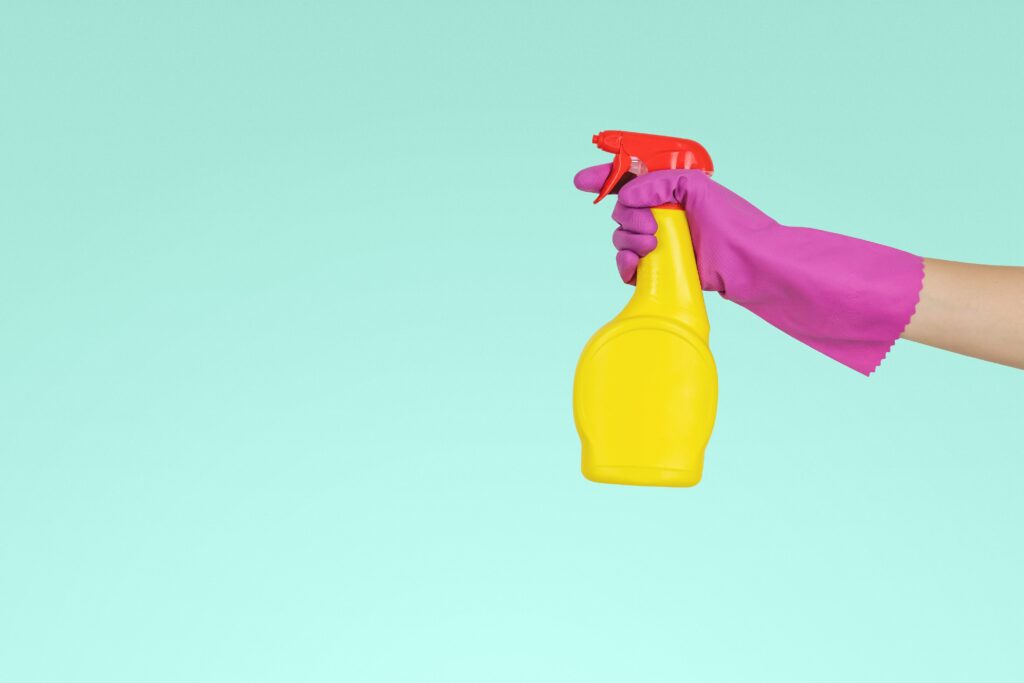
If you’ve landed on this page, it’s probably because you are looking to upgrade your cleaning routine. Or, maybe because you feel the current state of your home leaves a great deal to be desired. Don’t worry, you are not alone.
According to a survey conducted by OnePoll for affresh® , 65% of Americans admit their cleaning skills could be improved. Another study found that 54% of people find cleaning more stressful and time-consuming than any other task on their workload. Also, according to the IFS, 49% of married couples of school-aged children admit that the subject of chores and responsibilities is the #1 reason why they argue.
So, if you’re struggling in the home sanitization department, know that about 1 in 2 people feel the same.
I’ve had my share of struggles before I was able to create an effective cleaning routine. It took years before I came to understand the most important rule about cleaning a family home (more on this later).
Keep reading to learn more about my journey to how I created a cleaning routine that actually works or skip and go straight to the guide.
My husband R and I were married for almost 9 years before we had kids. During those early years of our marriage, my definition of housekeeping was what I liked to call “big cleaning days”.
Big cleaning days (usually taking place on a Saturday) basically consisted of me completely overhauling our 2-bedroom apartment, scrubbing and washing everything and anything in sight, including ceilings, fixtures, walls, baseboards, and windows.
Closets and kitchen cabinets were decluttered and rearranged where needed; big appliances were moved in order to ensure spotlessness behind them, and floors were vacuumed and mopped. In other words, I spring-cleaned our apartment about every 6 to 8 weeks… Ugh! The energy I had in my pre-kids era! A tear is almost forming at the corner of my eye…
On those “big cleaning days”, my frantic war against dirt and dust ended sometime in the late afternoon, when I finally sat down in my living room sipping on espresso and admiring my good work: a spotless apartment.
My housekeeping routine went on like that for years. I did the bare minimum on most weeks, then embarked on cleaning overdrive on a random Saturday to make up for lost time. It wasn’t perfect, but our place was actually quite clean most of the time and housekeeping did not feel like an issue at all.
How to Keep Your Home Clean After Having a Baby

After E was born, keeping our home clean became more of a challenge. My big cleaning days became more and more sporadic. By the time our second child (B) was around, we had moved into a 3-floor townhouse and, big cleaning days were almost nonexistent.
The thing is that I longed for my big cleaning days. Not so much the cleaning part (although our 3-floor mess could have used a scrubbing), but it was that empowering feeling that I missed: that satisfaction of seeing the job through and experiencing the result of my labor (which in this case was having a clean home for a few hours).
The End of Big Cleaning Days
Now, anyone who’s been a parent of little ones knows that, with babies and toddlers, the job is never done. There’s always a new mess, something you started but didn’t quite get to finish, and, for the stay at home mom that I was at the time, the sensation of not fully completing any task (ever!) drove me crazy.
I’m kind of ashamed to say that I often daydreamed of my next big cleaning day. However, when a scheduled big cleaning day actually came around and R took the kids on an activity for most of the day, I found myself sitting on the couch sipping coffee, before I even started the job!
The truth is that I felt too tired to move the fridge and stove or dust the ceiling fan. To be honest, I kind of enjoyed, well, doing nothing for once! I’d usually just end up tidying up the place and swallow up the feeling of complete failure before the family came back home.
In other words, “big cleaning days” turned into “me doing nothing days”, which wasn’t necessarily a bad thing, they just didn’t have the same self-fulfilling effect. Plus, our home remained in a dire need of a deep clean.
I obtusely insisted on maintaining this ridiculous housekeeping tradition until we had our third child (O), and we decided to move into our current home, which more than doubled the square footage of our previous townhouse.
I remember that, when we first moved, I was overwhelmed. There was no way I could possibly overhaul the entire place in one Saturday morning. No. It couldn’t be done. If appropriate sanitization was going to be maintained, it needed to be done in smaller, more manageable tasks.
Figuring Out How to Manage a Cleaning Routine
After mothering 3 children and over 15 years of living out of my parents’ place, I had finally understood the key to keeping a home clean: clean as you go.
It’s quite a simple concept, but one that many people (myself included) fail to follow. If your hamper is overflowing, you’re included too, Mama!
It’s just that, between the drop-offs and pickups, work schedules, kids activities and all our daily must-dos, the dust bunnies lurking behind the hutch quickly tend to plunge to number 1372 on our priority list.
Nevertheless, those bunnies won’t clean themselves, and they’ll continue to pile up behind our furniture (and our minds) no matter how much we choose to ignore them.
So, to solve my “big cleaning” issue once and for all, I came up with a routine that has actually been working for our family—at least on most days.
Why Is It Important to Have a Clean Home?
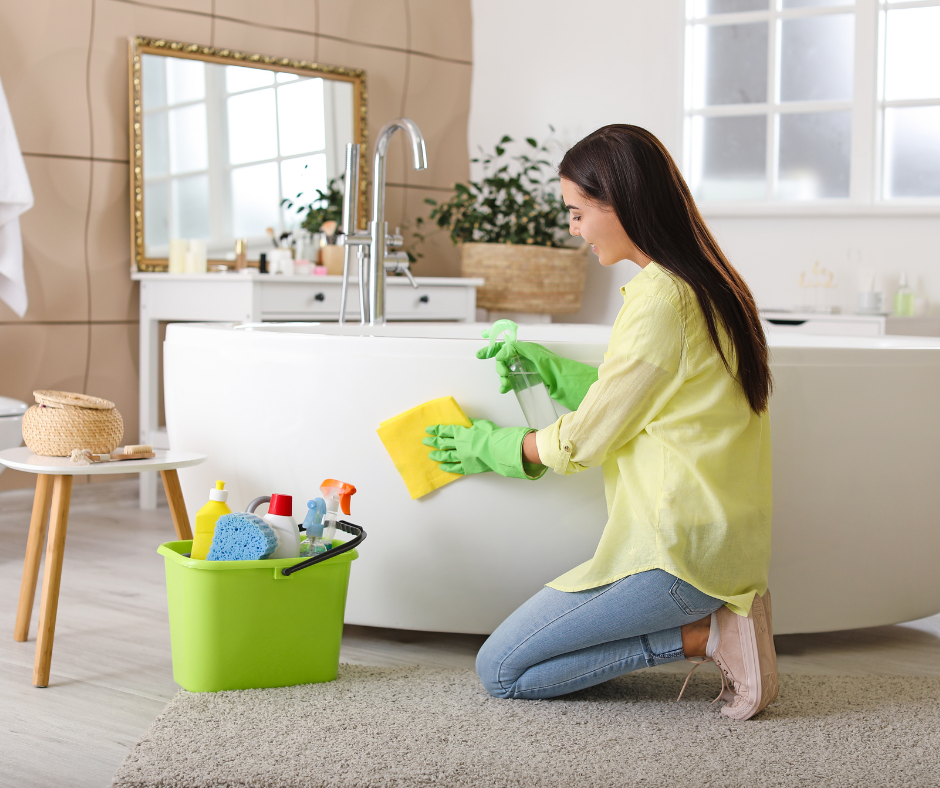
Housework is that thing that everyone wants to avoid, yet desperately wants to have down pat. But why is it so important for us to have a clean home? And why does it feel so darn stressful when rooms get messy?
No matter how much we all want to resist and convince ourselves that it’s okay to have a messy (or perhaps even dirty) house just because we have young kids, the hard truth is that science has proved us wrong. Here’s why.
1 – A Messy, Disorganized Home Can Affect Your Mental Health
A study completed in 2009, found that time spent at home feels either restorative or stressful. The study found that people living in cluttered environments actually developed higher levels of the stress hormone cortisol.
2 – Visual Mess Puts Your Brain Into Overdrive
Scientists at the Princeton Neuroscience Institute have proven that “Multiple stimuli present in the visual field at the same time compete for neural representation by mutually suppressing their evoked activity throughout visual cortex, providing a neural correlate for the limited processing capacity of the visual system.”
Translation: The region of the brain that processes visual information becomes overwhelmed when there is too much going on around us.
This means that even if you’re not consciously looking at the dishes on the counter, the mess on the table, the winter coat tossed on the armchair and the toys scattered all around on the floor, your brain still detects all these items at once and goes on a mini system overload.
This results in a decrease of working memory, a decrease in productivity and an increased feeling of fatigue. Over time, this can also cause your anxiety levels to skyrocket because your brain is just too mentally tired.
3 – Cleaning Your Home Regularly Can Help You Stay Healthy
Frequently touched surfaces such as doorknobs, light switches, handrails, toilets, faucet handles, and tables need to be regularly cleaned and disinfected in order to help prevent the spread of germs and, therefore, of illness. Here are the CDC recommendations on how to clean and disinfect your home.
4 – Regular House Cleaning Can Reduce Allergy Triggers
Vacuuming, dusting and cleaning different parts of your home helps reduce the presence of dust, allergens, pollen and mold in your home.
How to Keep Your House Clean

As mentioned above, for years I stubbornly tried to hang on to my old ways of looking at housework, but I finally came to the conclusion that I was no longer going to ignore bigger cleaning jobs and assume I could magically get them all done in a few hours on a Saturday morning. I finally realized that the key to maintaining a busy family home was to clean every day, not just tidy up, clean—every day!
Don’t cry Mama, I got you.
I figured out how to create a cleaning routine that is not just about removing the mess. It gets down to the nitty gritty of how to keep a home clean without pressure AND without taking too much time out of our already way too busy schedule.
Easy enough? Yes! Actually, it is!
Here’s how:
5-Step Guide to Having a Spotless Home
- STEP 1: Do a Walkthrough of Your Home & Make a List of Manageable Cleaning Tasks
- STEP 2: Review Your List of Tasks & Group them Together
- STEP 3: Enter Your Cleaning Tasks Into a WSAHM Matrix
- STEP 4: Create Your Daily, Weekly, Monthly and Seasonal Cleaning Routine
- STEP 5: Test Drive Your Cleaning Routines and Make Changes As Needed
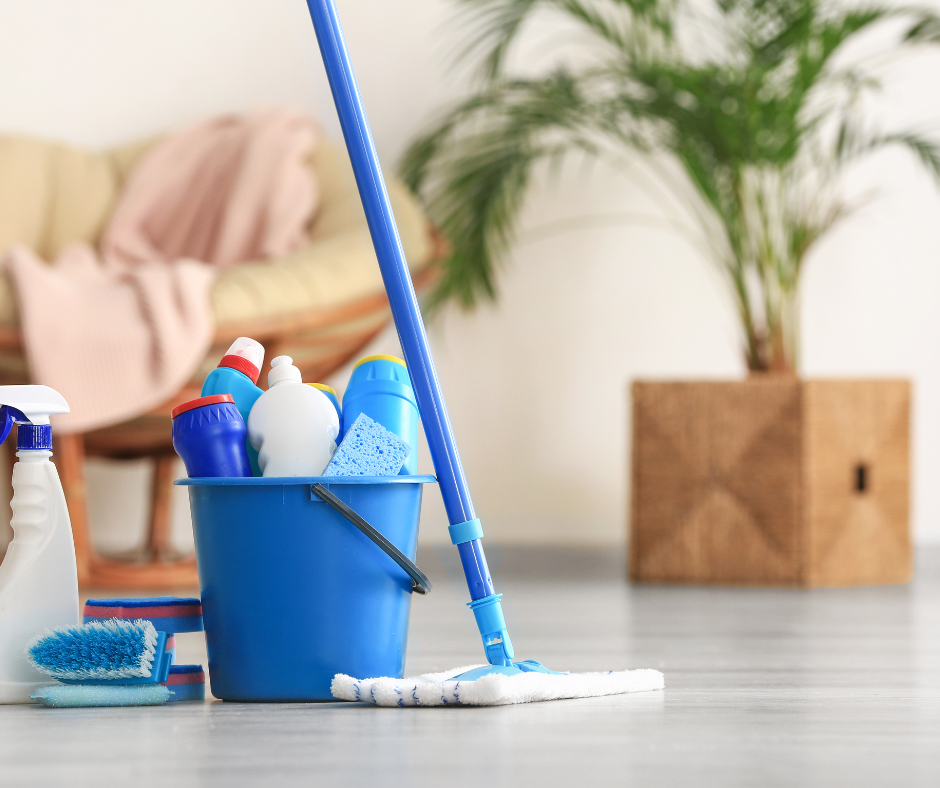
STEP 1: Do a Walkthrough of Your Home & Make a List of Manageable Cleaning Tasks
Walk through your home, observing every single room as if you were a Public Health Inspector.
When you stop in a room, ask yourself what works in the room, what doesn’t. If the room is over-cluttered, make a plan to declutter it (set a date and enter it in your calendar).
Then, make a list of the cleaning tasks you wish you could accomplish for each of the rooms in your house. Think spic and span and be specific. Break down the tasks as much as possible. For example, instead of just writing “dusting”, separate the task into “dust furniture”, “dust moldings”, “dust lamp shades and fixtures”, etc.
STEP 2: Review Your List of Tasks & Group them Together
Once you’ve completed your task list for each of the rooms in your home, see if you can group some of the tasks together. For example, you may have “dust furniture” for more than one room, like the living room, the bedrooms and the office. Reduce your list by grouping the same tasks together.
If you live in a multi-level home and prefer working on one floor at a time, you can also group the tasks by floor-level (e.g., “dust furniture – main floor”, “dust furniture – 2nd floor” and so on).
STEP 3: Enter Your Cleaning Tasks Into a WSAHM Matrix
Inspired by the Eisenhower Power Matrix and other time management techniques, I came up with the WSAHM Matrix to help me decipher how to prioritize my tasks.
In a nutshell, the WSAHM Matrix is made to help separate each task by merit (Essential, High-Impact and Low-Impact) and the time it takes to complete the task (less than 30 minutes, about an hour, and over an hour).
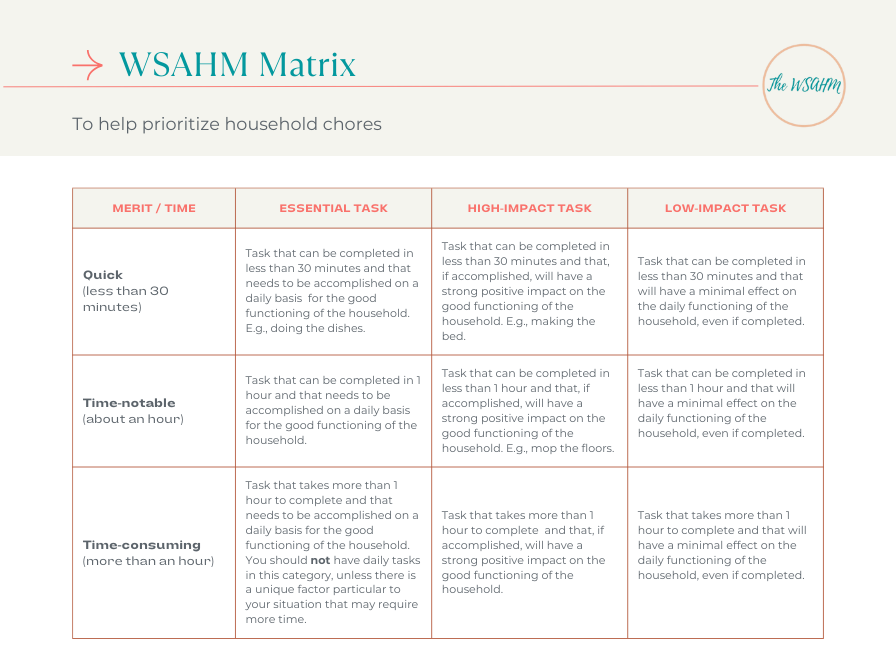
How to Create Your Own WSAHM Matrix
Start by separating each task by merit (Essential, High-Impact and Low-Impact).
An Essential task is a task that is absolutely necessary to accomplish daily in order for the household to function appropriately and in a calm, peaceful manner on any given day. Washing dishes is a good example of this. No household can run smoothly and calmly with a kitchen sink full of dirty dishes.
A High-impact task is a task that is not necessary for the basic functioning of the household, however, completing it will have a strong positive impact on either the daily functioning or the overall calmness of the household. The perfect example of this type of task is making the bed. Not getting around to making your bed in the morning will not stop you from accomplishing the daily tasks you need to do (such as cooking, laundering clothes, etc.). However, it has been proven that a tidy bed can actually have a positive impact on your well-being.
A Low-impact task is a chore that will have a minimal effect on the daily functioning of the household, even if completed. For example, the dust behind your fridge will not prevent you from accomplishing your necessary daily tasks.
Note, however, that tasks can move from one merit frame to the next. A low-impact task can move to high-impact or even become essential if it is neglected long enough. For example, decluttering the refrigerator may be a low-impact task until the fridge gets so messy that it becomes frustrating for you to put away your groceries or reach what you need to cook dinner. Another example can be how getting your winter accessories out of the storage bin might be a low-impact task in September, but it can quickly become an essential task if the weather unexpectedly turns colder.
Consider the Time It Will Take You to Finish Each Task
Once all your tasks are divided by merit, determine how long it should take you on average to complete each task. Categorize them as follows:
- Quick (less than 30 minutes)
- Time-notable (about an hour)
- Time-consuming (more than an hour)
Ideally, most tasks should fall under the “quick” or “time-notable” categories.
If you find yourself with several tasks in the “time-consuming” category, try to break them up into smaller tasks. For example, “Do the dishes” can be broken down into “empty the dishwasher”, “load the dishwasher”, “wipe the counters”, “clear the table”, etc.
Why Break Down Big Tasks Into Smaller Tasks?
There are two main reasons why it’s important to divide your tasks into smaller, less time consuming tasks:
- As a busy parent, you seldomly have a full hour to spare on a cleaning task, such as cleaning your whole kitchen. However, you might have 5 minutes to empty the dishwasher in between calls, 10 minutes to load the dishwasher after a meal, etc. In the end, all of it gets done; it just gets done in batches.
- Smaller tasks can easily be delegated to other members of the family. Now that my kids are older (10, 9 and 5), I rarely empty the dishwasher or clear the table anymore. These chores have been passed on to them.
STEP 4: Create Your Daily, Weekly, Monthly and Seasonal Cleaning Routine
Now that you know which tasks are essential to your family’s daily needs, which have a high positive impact on your day-to-day, and which are less important to the overall functioning of your household; AND you have allocated an average time frame to each of your tasks, you can determine how you will separate your tasks into daily, weekly, monthly and even seasonal cleaning routines.
As a general rule of thumb, your daily cleaning routine should include:
- all essential tasks
- as many quick high-impact tasks as possible
- and, if time permits, one or two low-impact tasks
Your weekly cleaning routine should include time-notable high-impact tasks and your monthly cleaning routine should mostly be time-notable low-impact tasks.
Save the time-consuming, low-impact tasks for your seasonal cleaning routine. Examples of this can be cleaning and organizing the garage or degreasing the stove hood.
Okay, I’ll admit it all sounds pretty confusing. To make things a little clearer I’m sharing my own lists below.
Notice how I’ve included no more than 10 tasks in each list.
Example of a Daily Cleaning Routine
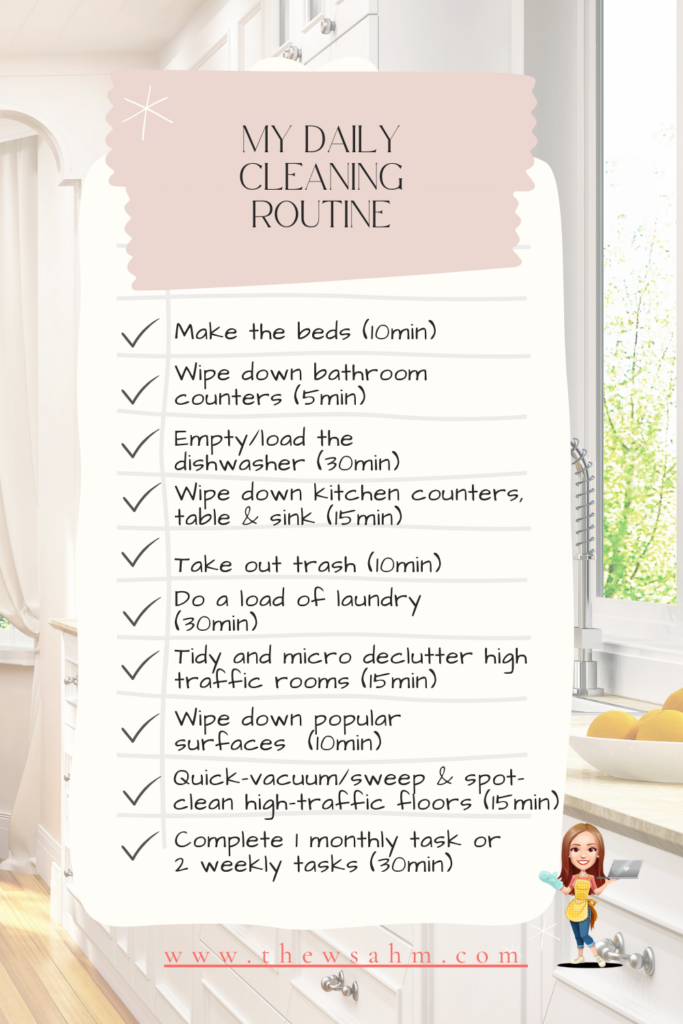
Notice how #10 is all about completing tasks from my weekly and monthly cleaning routines. This ensures that I don’t have to spend my Saturdays cleaning. My weekly, deep-cleaning tasks are completed as I move along the week.
I also added the average time I allocate to each of these tasks. However, please keep in mind that some of these chores are shared amongst me and the other members of my family (my husband and daughters). This is why I combined emptying and loading the dishwasher as 1 task. My girls are actually in charge of emptying the dishwasher.
Here’s how this routine translates to a perfect day in our household. Learn more about a Working Stay at Home Mom schedule.
Example of a Weekly Cleaning Routine
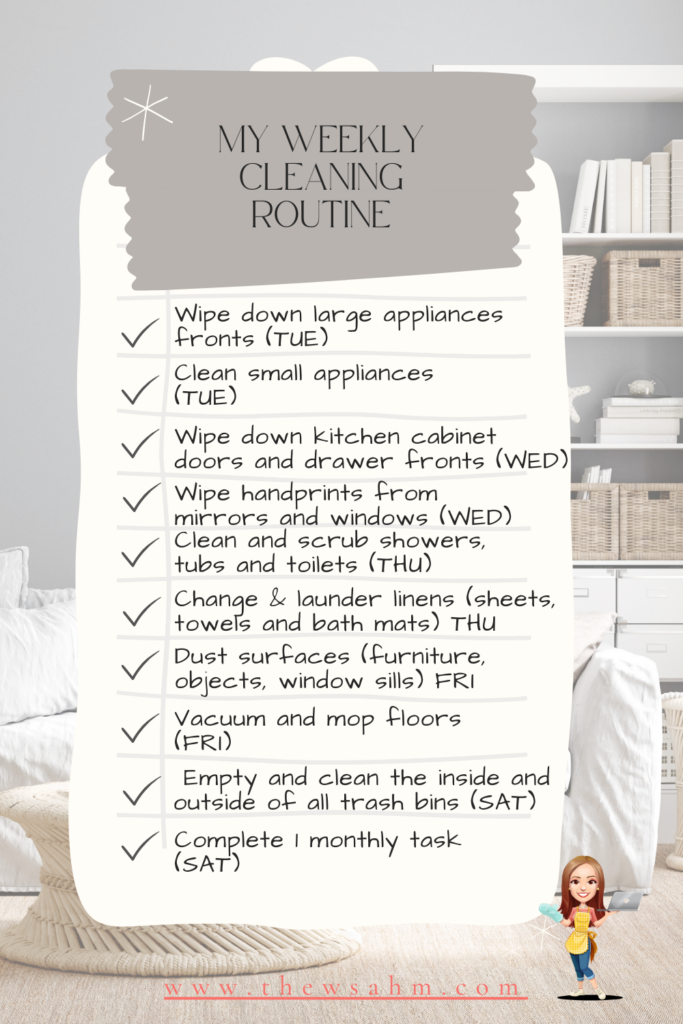
Notice how #10 is all about completing a monthly task (which is still included in the time frame of my daily routine) so I’m still not adding any extra work for myself.
I also assigned my tasks to specific days. Notice how I did not assign weekly tasks to my daily schedule for Sundays and Mondays. This allows me to take a break on Sundays and leaves me Mondays to catch up on any weekly chores I might not have had time to complete in the previous week.
Here’s how this all would translate in a perfect week in our household.
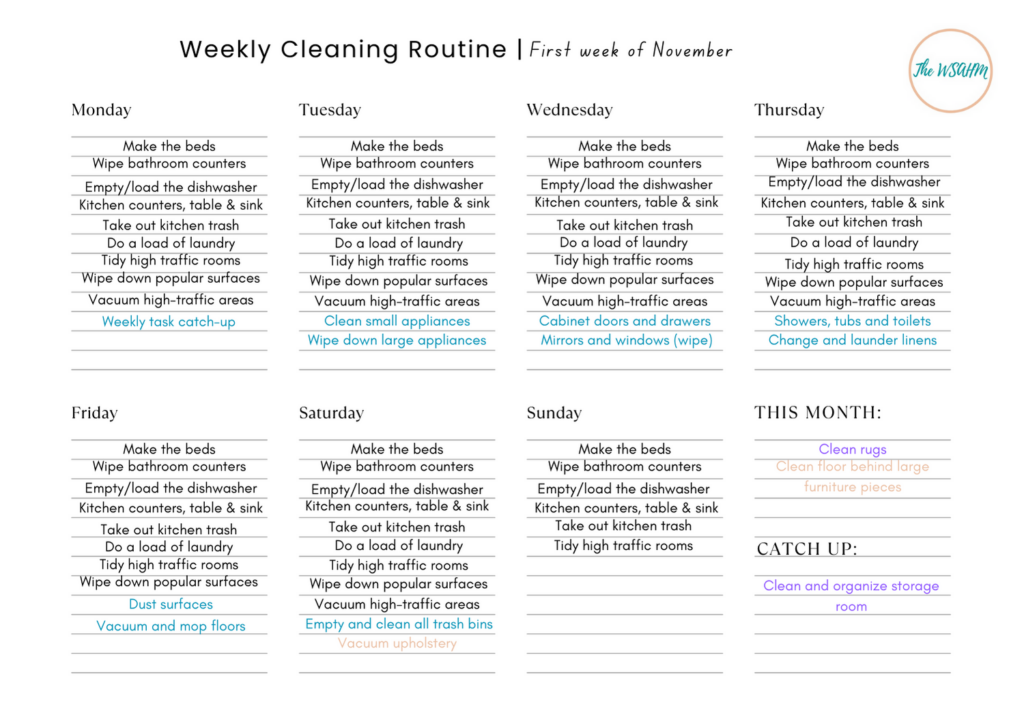
Notice how most tasks repeat themselves daily (these are my essential tasks), except for Sunday when I am okay with purposely slacking off and doing the bare minimum.
The tasks entered in blue are the tasks listed in my weekly cleaning routine.
The tasks entered in pink are monthly tasks and, finally, the tasks entered in purple are seasonal tasks (these lists are below).
I also made sure to include a “Catch up” section where I listed a task I didn’t get to last month. The “Catch up” and “This Month” sections include chores that have no allotted time in my daily schedule. They are low-impact tasks, so I will have to get to them when I can, hopefully within the current month.
Example of a Monthly Cleaning Routine
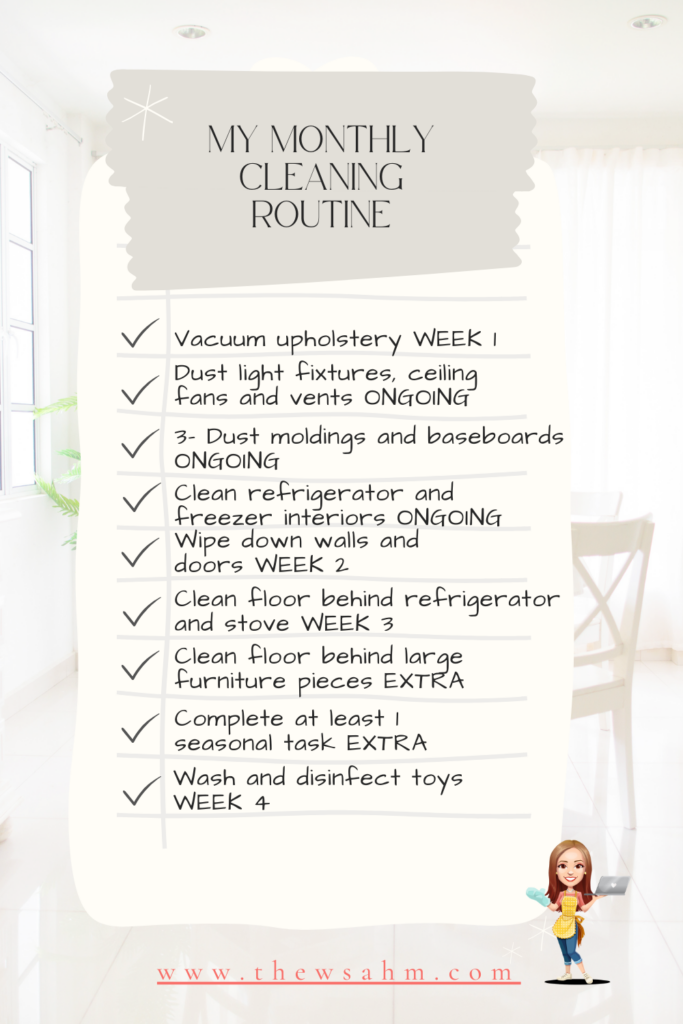
I have included how I separate these tasks within my schedule.
4 tasks have their own spot in my weekly to-do list (#10 in the weekly cleaning routine). 2 of the tasks require that I allocate extra time in my monthly schedule to complete them, and 3 of the tasks are what I like to call “ongoing”. This means that I complete them as I go along throughout the month. I might, for example, dust the baseboards while I mop the floor, or dust the light fixture in the dining room while I’m dusting the hard surfaces of the room.
My ongoing way of cleaning the refrigerator allows me to break this annoyingly lengthy task down into several micro tasks. Every time I come back from the grocery store, I clean out one section of the fridge before putting my groceries away. It’s true, I end up cleaning a part of my fridge every week, but it’s a five-minute job that will not impact my day’s schedule and the clutter in my fridge never piles up.
Example of a Seasonal Cleaning Routine
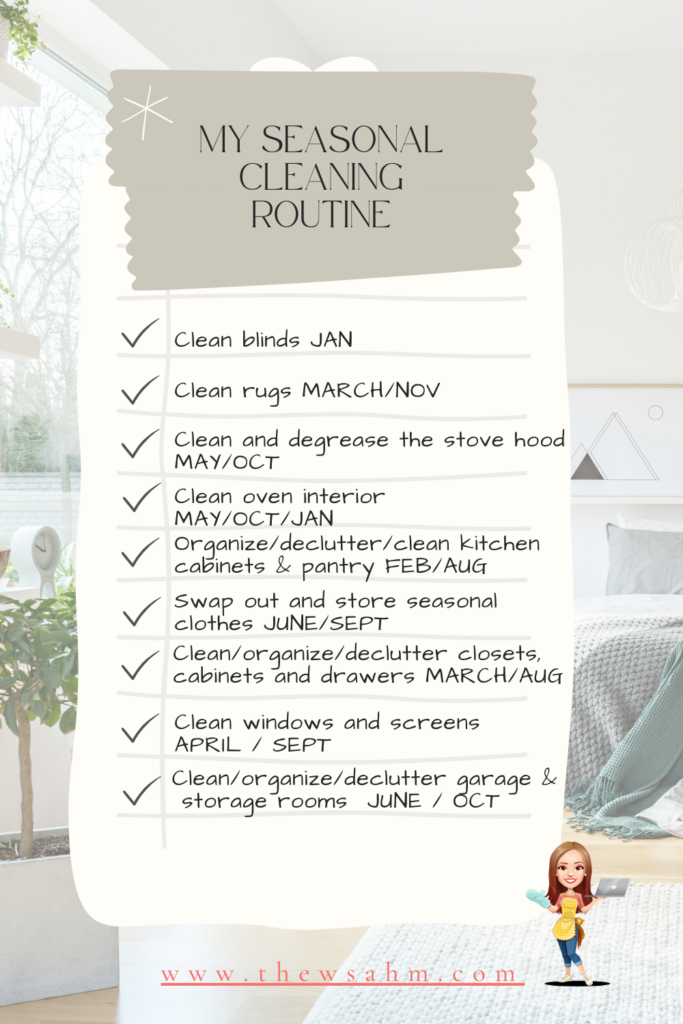
None of the tasks listed in my seasonal cleaning routine are included in my daily schedule. Extra time therefore needs to be allocated to my regular schedule in order to complete these tasks. I did, however, spread them by month. This makes it easier to find an hour or two somewhere in the month to complete the task.
STEP 5: Test Drive Your Cleaning Routines and Make Changes As Needed
Once you’ve come up with all your lists, try them out!
There will definitely be an adjustment period, especially if you’re not familiar with breaking down tasks. However, over the course of a few weeks, this way of doing housework should begin to feel more natural.
Remember that not all routines are created equal!
I have shared how I like to separate my tasks and the merit that I give to each specific chore, according to the necessities of my family. However, yours might look a little or even completely different, and that’s okay!
For example, I’m sure that parents of toddlers probably categorize picking up toys or tidying up the playroom as an essential daily task. Whereas I didn’t even include this task in my list. This is because my kids are now old enough to pick up their own toys and I clean the playroom in the same way I would any other room in the house. Find out more about how I organized my kids’ playroom.
A Few More Cleaning Tips to Keep in Mind
This process should feel rewarding!
If you are feeling stressed by your routine, reassess it. Maybe you are listing too many chores in one day, or maybe you have not allocated enough time to specific tasks? Remember that routines can always be revised according to the ever-changing needs of a busy family.
Remember to Be Kind to Yourself
The purpose of doing all this is not to become obsessed with checkmarking your days. It’s just a guideline to help you finally take control of your housework. Do what you can. If you only end up completing 50% of the tasks listed in your daily routine, great! At least those tasks are done!
Believe me, there are many days when I lag behind and end up sipping on a coffee instead of dusting the ceiling fan. The difference is that now I don’t feel guilty about it anymore. I just smile and tell myself “Oh well, I’ll just have to catch up on it tomorrow” 😉
Do you have a cleaning routine that works? Share it with other busy moms in the comments below.
Talk soon,
The Working Stay at Home Mom
Leave a Reply
heads up!
This site may contain affiliate links. As an Amazon Associate I earn from qualifying purchases. Please read the WSAHM disclaimer page for more information.
The advice on this site is general in nature and will need to be adjusted to your personal situation. If you have any concerns, please consult a trained professional such as your doctor or healthcare provider. More on this here
